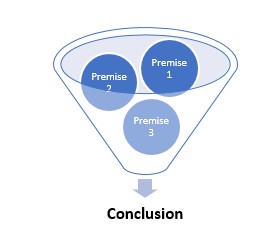Deductive Arguments
A deductive argument is a logical argument that uses premises to support a conclusion, with the guarantee that if the premises are true, then the conclusion must also be true. The premises provide evidence, reasons, and grounds for the conclusion. A deductive argument follows the following structure.
- Premises: One or more statements that provide evidence or reasons.
- Inference: A logical connection between the premises and the conclusion.
- Conclusion: A statement that follows necessarily and logically from the premises.
The premises can be either true or false but can’t be both. The inference is the process of reasoning from the truth of the premises to the truth of the conclusion. A good logic means that if the premises are correct, then the conclusion naturally follows. For instance, consider the following argument,
- Premise 1: All humans are mortal.
- Premise 2: Socrates is human.
- Conclusion (or Claim): Therefore, Socrates is mortal.
In this case, the premises (1 and 2) provide the evidence and reasons, while the conclusion is the claim being argued for, which logically follows from the premises. If the premises are true, the conclusion can’t be false.
We can depict an argument in the form of the following diagram.

Deductive arguments guarantee the conclusion because the conclusion is already contained in the premises. Hence, it does not create new knowledge but only derives logical conclusions based on premises. Syllogism is a valid deductive argument having two premises and a conclusion.
A deductive argument is either valid or invalid.
Valid Deductive Argument
Example
- All cats are animals.
- Cathy is a cat.
- Therefore, Cathy is an animal.
In the case of valid arguments, the conclusion is irrefutable and certain if the two premises are true. The argument is valid since asserting the premises and denying the conclusion is impossible.
A deductive argument is considered invalid if even one such case is established, which proves the conclusion wrong if premises are assumed to be true.
Example
- All cats are animals.
- Cathy is an animal.
- Therefore, Cathy is a cat.
The above argument is invalid since Cathy can be any animal, such as a dog, fox, or tiger. Hence, just because Cathy is an animal, it does not follow that Cathy is a cat.


